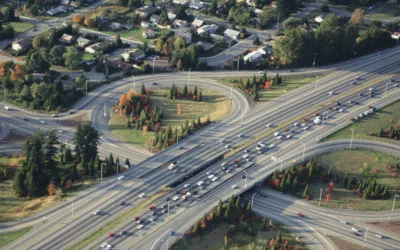A 2017 report by McKinsey entitled The new age of engineering and construction technology presents the advantages for the engineering and construction (E&C) industry to embrace and adapt to new specialised technologies. Advanced software applications, construction-focused hardware and intensive analytics are all part and parcel of streamlining a previously labour intensive information sharing system that was fraught with the possibility of human error.
Intelligent modelling processes such as BIM (Building Information Modelling), which enables the generation and management of data rich models, capturing the physical and functional characteristics of places has made a positive impact in the E&C industry.
One of the most important features of the modern engineering world is the need for real-time communication between a multitude of professionals from engineers to architects to construction foreman, coupled with the accurate analysis of data. GPS technology is one of the features that has been incorporated into the industry in an effort to create an integrated network that boosts productivity by saving on time and improving accuracy.
What is GPS and how does it relate to the industry?
Global Positioning System, or GPS, is defined as ‘a space-based satellite navigation system’ that provides location and time information, anywhere on or near the Earth.”
Since its inception, GPS has proven critical in its application in the military, civil and commercial sectors.
How does GPS work? A GPS receiver calculates its position by timing signals sent by GPS satellites orbiting the earth. GPS ‘listens’ to and applies these signals only – in other words, it does not transmit any outbound signals. GPS often requires multiple signals from no less than four satellites in order to establish a firm fix on location. This is why you often receive poor signal when you’re in a tunnel or an underground parking lot. Once a GPS device has received all the necessary information from the satellites, it can accurately calculate a location.
Due to its excellent and dependable navigational capabilities, GPS has become a must-have in all aspects of global infrastructure. The technology now has applications in almost every commercial or industrial field. It isn’t just a tool to help you get out of a jam when you’re lost in the big city or traipsing off to the countryside on the annual family holiday. Here are some of the global industrial applications that rely on GPS to improve their overall bottom line:
- Aviation: GPS assists with safety and efficiency. Not only does GPS have forecasting abilities when it comes to weather conditions, predicting storms and other environmental changes, but it ensures speed of delivery for emergency services like search and rescue. The same applications are used in the commercial maritime industry where accurate methods of navigation, given its dependency on the natural environment, is an essential component for efficiency, safety and productivity.
- Agriculture: GPS has enabled the development of precision-driven agricultural practices or ‘smart’ farming by combining with the Geographic Information System (GIS). This combination has enabled the pairing of real-time data collection with accurate positioning resulting in the efficient analysis of voluminous data.
- Railways Systems: GPS can track the movement of trains and railcars in real time. Combined with other digital resources, like computerised communications’ systems, GPS improves security and operational effectiveness by reducing accidents, delays and operating costs.
GPS in technology – the benefits
GPS in the engineering and construction industry adds to improved safety and accuracy. A vehicle or equipment that is fitted with GPS provides a detailed report of the usage. This serves to improve the driving or usage habits of staff members. Vehicles or equipment can be tracked and monitored in order to prevent misuse, which all adds to the longevity of highly valuable assets.
GPS can also be used to track the best and fastest routes to a destination, monitor traffic patterns in order to avoid congestion and calculate a predetermined route around a construction site. GPS can also automate record keeping as well. This is a huge saving in the field as manual record keeping is both time-consuming and subject to human error. Historical GPS data can assist with fuel estimations, labour capabilities, equipment maintenance and billing. All of these accuracies contribute to more precise budget appraisal and project management.
In addition to which, GPS technology affords companies choices and opportunities that were not previously a possibility.
GNSS Technology – learning to fly
When combined with GNSS technology, GPS can be used for devices in tracking and mapping, and industrial machinery. GNSS stands for Global Navigation Satellite System, which is the navigation system that provides autonomous, geo-spatial positioning with global coverage. The term includes GPS, GLONASS and Galileo technologies.
GNSS was originally used for military use only but has since branched into civil, industrial and scientific arenas where it has made inroads in agriculture, mining, logistics and offshore oil drilling platforms. This is because the E&C industry makes use of heavy-duty machinery that can be automated using GNSS technology especially when working in inaccessible areas or in an effort to reduce the cost of manpower (like rigorous or accredited training procedures). One of the most commonplace practices by which to utilise GNSS technology is land surveying, which has been perfected by leading manufacturer, Topcon Positioning. Topcon designs and distributes precise positioning products and solutions for the surveying, construction, agricultural and engineering industries with BIM, mapping and geographic informations systems (GIS) amongst others.
Land surveying is a technique used in E&C to accurately measure distances and angles between different points. The data collected is both highly accurate and expediently obtained. GNSS survey equipment makes use of satellite based augmentation systems to dual frequency receivers. Survey types include: static surveys, dynamic surveys and real-time dynamic surveys.
These devices offer the user a compact and universal tracking apparatus with multiple communication tracking channels ensuring accuracy in data collection and analysis. Sometimes, the E&C industry makes use of autonomous vehicles when navigating an area that is to be surveyed. This comes in the form of a UAV (unmanned aerial vehicle) such as a drone. These are guided by a grounded pilot and the GNSS contributes by providing feedback to the control algorithm. UAVs are used in the navigation of aerial surveys using cameras or radars where they either monitor or collect information from the relevant surface. This is particularly useful when surveying inaccessible or dangerous areas (like mining sites) or if the surveyed area covers an extended surface area.
With GPS technology already utilised successfully in a range of difficult applications from software to hardware, the trend is steering steadily towards automation of heavy-duty machinery and equipment in order to improve accuracy and refine costs.
Technology can help you refine your business safely, efficiently and accurately. At Baker Baynes we offer leading technology for the right applications. Get in touch and learn more about our products and services.




0 Comments